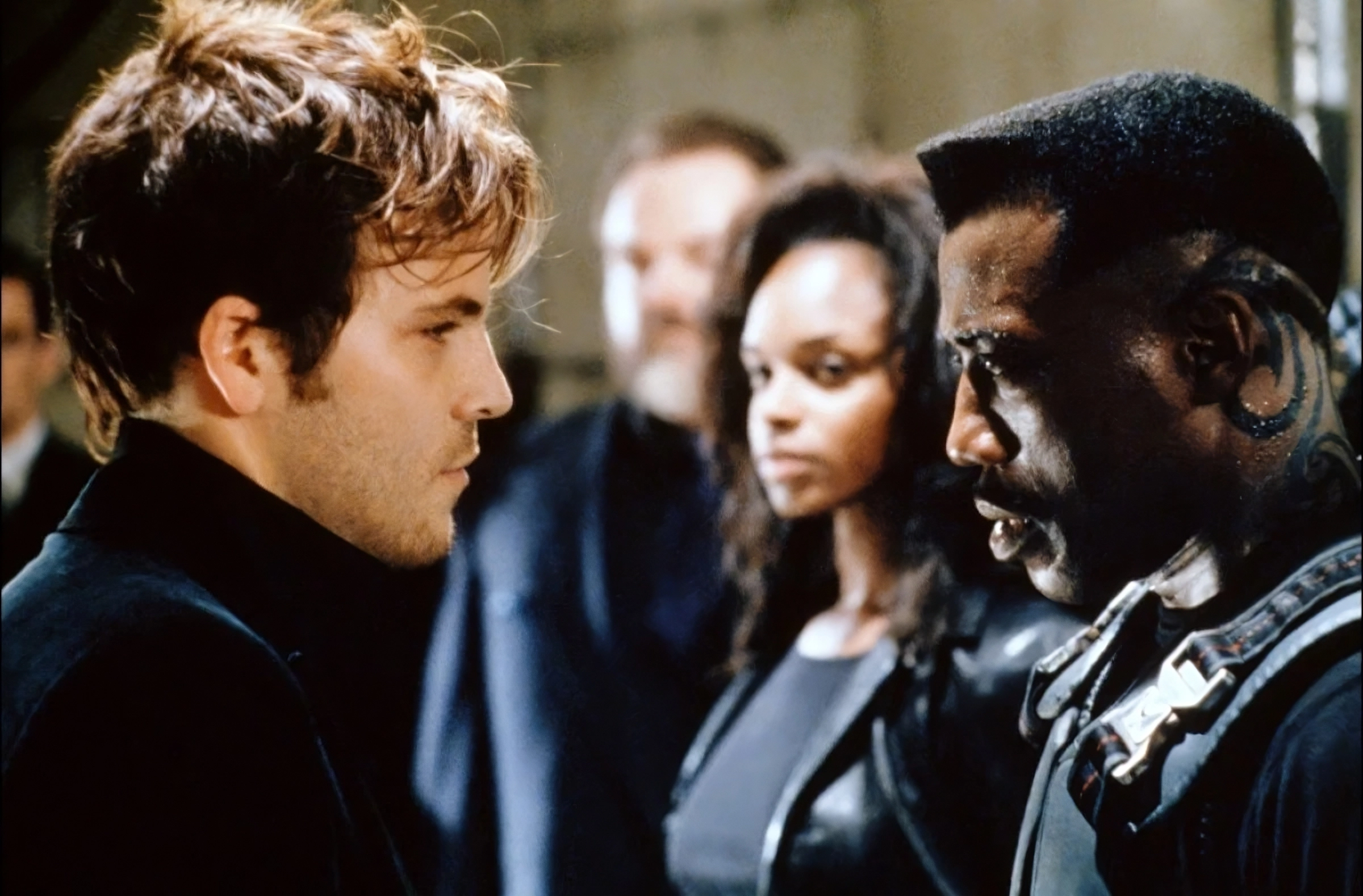In 1998, the movie “Blade” carved a unique niche at the crossroads of the supernatural and the cinematic. It brought to life a lesser-known Marvel hero through the formidable presence of Wesley Snipes. This film not only reimagined a comic book character but also laid the groundwork for the future of superhero cinema. It was a bold mix of raw action and a complex hero.
Our retrospective journey takes us into the film’s captivating charm. We focus on Snipes’ compelling portrayal and the cutting-edge special effects that vividly realized a world shrouded in darkness. As we traverse the haunts of Blade’s urban battleground, we explore how this film left an indelible mark on its genre. More than twenty years on, “Blade” remains a seminal piece that continues to influence fans and filmmakers alike.
The Genesis of ‘Blade’
Before Wesley Snipes breathed life into Blade, the character lurked in the pages of Marvel comics. Blade — a creation born from the imagination of writer Marv Wolfman and artist Gene Colan. Initially a supporting character, Blade’s transition to the silver screen was not just a leap across mediums but a reinvention that would cement his place in the pantheon of cinematic superheroes.
The development of the “Blade” film adaptation was a testament to the character’s versatility and the creative vision of its team. The filmmakers sought to craft a narrative that honored the comic’s essence while innovating within the genre. They envisioned a world where gothic horror met urban decay, a setting ripe for a hero with Blade’s unique skill set and moral complexity.
Wesley Snipes, already an established actor with a penchant for action roles, saw potential in Blade. He not only starred as the titular character but also served as a producer, deeply involving himself in the film’s creative process. Snipes’ commitment to authenticity was evident in his rigorous physical training and martial arts practice. It was ensuring that every fight scene conveyed both the character’s prowess and his personal style.
As “Blade” began to take shape, anticipation built. Audiences were unfamiliar with the vampire hunter’s lore, yet there was an air of excitement around the film’s bold promise. It pledged to deliver an experience that was as much a horror flick as it was a superhero saga — a hybrid that was uncommon at the time.

Plot Overview
“Blade” unfolds as a compelling tale of vengeance and salvation, where the protagonist stands as humanity’s reluctant guardian against a subterranean world of vampires. The film opens with Blade’s traumatic origin story, which doubles as a catalyst for his lifelong crusade against the undead. His mother, bitten by a vampire during pregnancy, gives birth to him before succumbing to her transformation, leaving Blade straddling the worlds of light and dark.
The narrative propels forward with Blade’s relentless pursuit of the vampire underworld, led by the malevolent Deacon Frost. Frost’s ambitions threaten to escalate the vampire threat from the shadows into a global apocalypse. Blade, with his hybrid vigor and arsenal of weaponry, emerges as the singular force capable of thwarting this plan.
Throughout the film, themes of identity, belonging, and transformation are explored. Blade’s struggle with his dual nature — his human empathy warring with his vampiric instincts — adds a layer of depth to the action-packed storyline. The movie also doesn’t shy away from the moral ambiguities of its characters, allowing the audience to ponder the nature of antiheroes and villains alike.
The plot weaves through intense action sequences and dramatic confrontations. It also pauses to reflect on the notion of legacy. Blade’s fight is not just about survival. His goal is to create a world in which people can live free. Free from the fear of predators lurking in the darkness.
Cultural Impact and Legacy
When “Blade” sliced into theaters, it didn’t just entertain. It left a lasting impression on the cultural zeitgeist of the late ’90s. The film’s success proved that a superhero movie could be dark and gritty, paving the way for future franchises to embrace more mature themes. It was a harbinger for the likes of “X-Men” and “Spider-Man”, which would help to establish the superhero genre as a box office staple.
The portrayal of Blade by Wesley Snipes, with his stoic demeanor and martial arts prowess, challenged the prevailing stereotypes of African American actors in action roles. Snipes’ Blade was a hero of few words but immense presence, breaking racial barriers and becoming an icon for diversity in superhero films.
The critical reception at the time was a mix of admiration for the film’s style and action, with some skepticism towards its horror elements. However, as the years have passed, retrospectives have been kinder, often citing “Blade” as a cult classic that was ahead of its time. The film’s blend of vampire mythology with superhero action was seen as a bold move that paid off in establishing a loyal fan base.

Technical Artistry: Visual and Special Effects
“Blade” was also a showcase for the special effects capabilities of the late ’90s. The use of CGI was still in its relative infancy, and “Blade” managed to strike a balance between practical effects and digital enhancements. The result was a series of memorable set pieces that felt tangible and thrilling, from Blade’s swordplay to the vampires’ gruesome demises.
The film’s aesthetic was a significant departure from the bright spandex of earlier superhero movies. Its darker color palette, combined with a rave-inspired soundtrack, captured the underground club scene of the era, resonating with a youth culture steeped in the emerging electronic music movement.
Sequels and Franchise Evolution
“Blade” did not merely end with the credits of the 1998 movie. It sired a franchise that expanded its lore across two sequels: “Blade II” and “Blade: Trinity”. Each sequel delved deeper into the vampire mythos and explored new facets of Blade’s character. Directed by Guillermo del Toro, “Blade II” introduced a new breed of vampires, the Reapers. Thus offering a fresh take on the vampire hierarchy and aesthetics. The third installment, while met with mixed reviews, expanded the narrative universe by introducing additional characters from the Blade mythology.
Beyond the big screen, “Blade” also inspired a television series and animated features. Which cemented its status as a versatile and enduring franchise. The character’s influence extends into video games and comic book revivals, showcasing the lasting appeal of the Daywalker.
Current Pop Culture Standing and Future Prospects
Today, “Blade” from 1998 holds a place of reverence among the pantheon of superhero movie. It is often credited with proving the viability of Marvel properties in cinema, setting the stage for the Marvel Cinematic Universe (MCU). The announcement of a new “Blade” movie within the MCU, with Mahershala Ali taking up the mantle, has reignited interest in the original trilogy and sparked conversations about the character’s future.
The legacy of “Blade” is evident in the continued popularity of darker, more complex superheroes. The film’s influence can be seen in the tone and style of many modern superhero projects. They often seek to balance human drama with supernatural elements.
Conclusion
We reflect on the “Blade” franchise’s journey from a bold cinematic experiment to a cornerstone of superhero cinema. Its significance cannot be overstated. Wesley Snipes’ portrayal of Blade remains a defining moment in his career and in the genre at large. The upcoming reboot is a testament to the character’s enduring appeal and the film’s place in the cultural lexicon.





